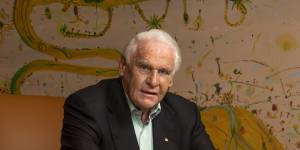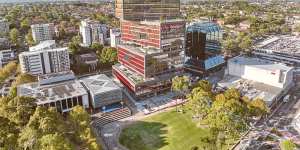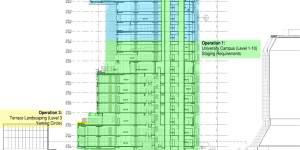On a showery Friday morning in May,several hundred mourners,including a former prime minister and at least three billionaires,gathered at Sydney’s Town Hall to farewell a tycoon.
Lang Walker,who died in January aged 78,had amassed a $5.8 billion fortune over six decades,transforming the earthmoving,excavation and quarrying business he founded in 1964 into one of the country’s largest private property developers.
Speakers at the memorial service paid tribute to the business acumen of Walker,who left Jannali High School after year 10,as well as his sense of humour;earlier in life,he’d been known to quip,“It’s only a rort if you’re not in on it”.

Founder and chairman of Walker Corporation,Lang Walker,died in January. Louise Kennerley
“He was quintessentially larger than life,” Barney Glover,the recently departed vice-chancellor of Western Sydney University,told the mourners. Both hard- and soft-edged,Walker was driven and charismatic,“an imposing man,never to be underestimated”.
Special mention was made of his philanthropy. In 2019,he donated $26 million to Western Sydney University for a new professorship and a medical research building at Campbelltown.
But while Walker gave generously to the university,his company,Walker Corporation,stands to gain far more.

Hundreds gathered to farewell the “never to be underestimated” Lang Walker at Sydney’s Town Hall in May.Dion Georgopoulos
TheHerald has been examining the deal behind the tallest building in Bankstown in Sydney’s west,an award-winning 18-storey tower that is half university campus and half commercial office block.
(The students content themselves with the lesser views in a building that was,according to planning documents,designed “purely for educational purposes”.)

Walker Corporation spent $340 million to deliver the 18-storey building.Walker Corporation
Walker Corporation delivered the project and paid the $340 million upfront cost.
But it stands to make at least five times that much from its client,Western Sydney University,which has been accused of overpaying by as much as $1 billion under decades-long contracts entered into without a tender while Walker remained company chairman.
The new building,which opened in December 2022,sits on public land.
The university leases the site from the Canterbury-Bankstown council and then subleases it to Walker Corporation for a peppercorn rent. Then,through another sub-lease,the roles are reversed.
Walker Corporation becomes the landlord of the building,receiving tens of millions of dollars each year.
One property finance specialist has described the deal as a win-win for the developer and a university lacking in piles of spare cash.
However,another observer believes WSU,which relies on government funding and student fees,could have saved hundreds of millions of dollars had it opted to borrow development funds from a bank.
“It does seem unnecessarily complex,risky and expensive for Western Sydney University,” says David Parker,a former NSW valuer-general.
“It’s a very curious deal.”
The land and the bold plan
Compared to its older,sandstone rivals,WSU has fewer high-fee-paying international students and postgraduates to help fund new works.
But under Glover,the former vice chancellor who eulogised at Walker’s memorial and who co-signed the Bankstown leases,the university devised what it called an “innovative” model.
Rather than own its new campuses outright,it would lease them instead.
“We see great value in having great campus facilities in the heart of the CBDs of western Sydney,” Glover toldTheAustralian Financial Reviewin 2019.
“That gives us proximity not just to businesses for placements but universities attract organisations around them,and that gives us an opportunity to catalyse urban renewal.”

Former Western Sydney University vice-chancellor Barney Glover speaks at Lang Walker’s memorial.Dominic Lorrimer
A public list of contracts shows the university has six long-term leases with a range of property developers to provide new campus space in suburbs including Parramatta,Westmead and Liverpool.
Each was entered into without a tender and the combined cost of these deals is $2.8 billion.
By far the largest of these is Bankstown,where the university had ambition,a bold plan and public land.
Canterbury-Bankstown Council and the university entered into a partnership in 2019 for the university to use a council-owned site that had been a car park and an adjoining grassy area. In 2021,the council formally granted the university a 99-year lease.
In exchange,the university agreed to pay the council $1 rent a year and a one-off sum of $12.9 million.

The university campus occupies the bottom half of the 18-storey building.Walker Corporation
A council spokesperson said the payment was “fair and appropriate” and that “the ground lease on the property was negotiated after a detailed and extensive independent valuation process”. The spokesperson added that the lease to the university had been approved by the elected council.
But independent councillor and former deputy mayor Barbara Coorey said she was shocked by the amount of money Walker Corporation stood to make,and she had only learnt that half the building would be commercial premises after it had been built.
“Ratepayers have been shortchanged in this highly unusual and controversial land deal to the tune of tens of millions of dollars,” Coorey said.
“This is very valuable civic land in a prime commercial zone that was handed over with very little transparency and accountability”.
When Coorey asked the council about the $12.9 million payment from the university,the council said the circumstances were “subject to confidential reports”.
The deal
Having clinched the site,the university needed a developer.
The full details of the partnership between Walker Corporation and the university are contained in a confidential development agreement.
But public lease documents show the university agreed to lease the Bankstown site to Walker Corporation for $1 a year for 98 years.
Walker Corporation agreed to foot the bill for the building’s design and construction costs,which added up to $340 million.
Then,to pay the developer back,the university agreed to rent the whole of the premises from Walker Corporation for 40 years.
But this time,the cost was not $1 per year.
The university is forecast to pay Walker Corporation an average of $45 million annually for 40 years – a total of $1.8 billion,according to the university’s list of contracts.
The amount is roughly five times the upfront project costs.

Inside the Bankstown campus.HDR Architecture
When that lease ends,the university will need to strike a new deal with the developer if it wants to continue occupying the building.
Parker,the former NSW valuer-general who now works as an independent property consultant,said WSU could have approached a major bank to finance the construction costs instead.
“Over the life of the loan,they would pay an awful lot less than $1.8 billion,” he said.
“I would suggest it’s a lot like somebody who can’t afford to buy a new car and does one of those hire-purchase lending deals and ends up paying five times what the car would have cost.”
Parker estimates the university could have saved up to $1 billion on the project.
‘A rock and a hard place’
But Michael Cook,a former longtime executive at Investa Property Group who now runs his own advisory firm,Cook Commercial Investment Group,said the deal looked like a good one for both the developer and the university.
“They’ve kind of nailed it,” Cook says,pointing to extra revenue the university stood to earn from student fees and subleases at a well-located campus.
“The fees that they would earn out of that building would be enormous. That gives them cashflow above and beyond what they would have had they not built the building.”

Walker Corporation chairman Lang Walker and former Western Sydney University vice chancellor Barney Glover. Sally Tsoutas,Western Sydney University
While acknowledging the university would pay several times more than what Walker Corporation spent,Cook doubted WSU would have been able to borrow hundreds of millions of dollars for the upfront costs.
“They are kind of between a rock and a hard place,” he says.
“They have all the demand for university places and for courses – that generates fees. But they don’t have the capital upfront.”
The project,which received a height exemption to reach 86 metres,makes WSU into an office landlord that will have to find tenants for the top half of the building.
Under the main lease,only 50 per cent of the building must be used for university purposes.
But planning documents had stated the tower was designed “purely for educational purposes”,with a handful of floors set aside for industry partnerships.

A 2022 progress report from Walker Corporation marked the top floors for “educational use”.Walker Corporation
When the building was approved as a state-significant development,its official use was listed as “university with ancillary retail”,referring to shops on the ground floor.
No mention was made of commercial premises.
A Department of Planning spokesperson said that after investigating the building’s use,it concluded “there has been no breach of the development consent”.
A spokeswoman for WSU said:“The university is the whole-of-building tenant under its occupation lease,which allows for expansion,growth opportunities,and collaboration with industry partners for teaching,learning,and research.”
The spokeswoman said the building was “not only iconic and aspirational,but designed to meet the specific needs of the university”.
Campus to be demolished
The rise of Bankstown is linked to the demise of the university’s campus at nearby Milperra,which sits on a leafy 20-hectare site it received from the state government for $1 in the 1990s.
The university now plans to raze the campus and turn the land into a residential housing project led by the developer Mirvac,a move the council opposed and that has angered parts of the local community.

A community protest against the residential development of Western Sydney University’s Milperra campus.Louise Kennerley
“It’s the squandering of an irreplaceable resource,” said Paul Judge,a community campaigner whose three children attended the campus.
Judge said while the former Liberal state government approved the residential project,private development was never envisaged when the land was first granted to WSU.
The university had argued it was hard to attract students to Milperra,whereas the Bankstown campus was closer to public transport and job prospects. According to a 2020 ministerial briefing note,the Milperra windfall was meant to help fund Bankstown.
Glover,the former vice chancellor who in February became the Albanese government’s new jobs and skills commissioner,referred theHerald’s questions to the university.
The university declined theHerald’s request for an interview.
In response to written questions about the Bankstown project,a spokeswoman said:“The process was overseen and signed off by an independent external probity adviser and the commercial aspects of the project were independently assessed.”
On the question of how the deal demonstrated value for money,the spokeswoman said the university’s approach was to invest in teaching and research and not “tie up capital in construction costs”.
“If the university were to perform the role of developer,this would have necessitated capital costs being funded from borrowings,thereby incurring interest costs,” the spokeswoman said.
“The 40-year cost of the building occupation sublease arrangements needs to be assessed against the low upfront costs to build new student and civic amenity,and lower running costs afforded by the Bankstown CBD campus.
“In today’s dollars,the 40-year leasing cost to the university is approximately $389 million,not $1.8 billion. This excludes any strategic benefits,sublease revenue,collaboration arrangements,or other cost recoveries from industry partners.”
A Walker Corporation spokesperson said the project followed a “commonly used” commercial approach,which allowed the university “to avoid the upfront expenditure,ongoing loan repayments and risk of development”.
“Our lease payments from WSU over a period of 40 years are of a fair and comparable value to similar whole building commercial leasing structures we have in place from the same time the deal was initiated,” the spokesperson said.
“Walker will continue to manage the building facilities,concierge and security services and take these adjustments into its capital expenditure.”
The spokesperson said Walker Corporation was proud to have delivered a “world-class” campus,having overcome severe constraints on the construction industry through the pandemic.
Start the day with a summary of the day’s most important and interesting stories,analysis and insights..